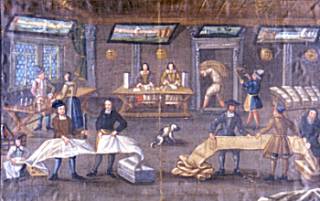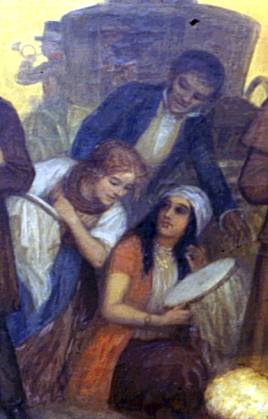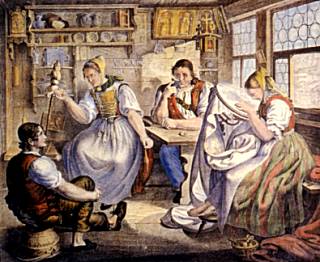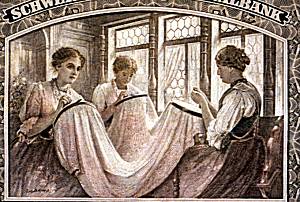| |
At first I would like to
remember dates to the linen and cotton trade in
Switzerland. In the eastern part of Switzerland
there was a flourishing linen trade since the 13th
century. St. Gallen maintained close relations with
leading European cities from Spain to Poland, which later
was the basis for the trade with embroideries.
In the 14th century tradesmen from Basle had been buying
white and coloured fustians as well as raw cotton for the
local weaving industry. Somewhat later cotton wool was
spun in Zurich. Mostly the poor population made some
money in manufacturing cotton. This changed in the 18th
century when a lot of people preferred spinning to
fieldwork. The writer Ulrich Braeker tells of cotton
spinning in Toggenburg around 1730.Between 1720
and 1770 a french refugee, Peter Bion,
introduced manufacturing and trade of cotton in St.
Gallen.
It is said that the cantons of Appenzell and St. Gallen
dominated in the second half of 18th c. the entire cotton
weaving industry in Europe. This development ended with
the introduction of english Machine yarns in the 1790s.
In 1800 there were still about 100'000 spinners in
Switzerland, a number which diminished to 6'000 only 14
years later.
Embroidery in the Eastern part of Switzerland:
The first document of an embroidery order dates from 1753.
But the story goes, that a tradesman of St. Gallen saw
turkish women in Lyons doing chainstitch embroidery
already around 1750 and he invited them
on the spot to St. Gallen where they demonstrated their
art in the market place and instructed the women of the
town in this new skill. It seems that many women who had
lost their job as spinners turned to
|
|
embroidery. A document 20
years later, in 1773 names 6000
embroiderers in eastern Switzerland. according to the
historian H. Wartmann thirty to fourty thousand persons
were employed by 1790. This high number seems incredible,
we believe that it includes all workers in the textile
branch in the region. In a letter Goethe writes of a
very fine embroidery that he bought in a manufacture near
St. Gallen. Interesting enough of this period only very
few pieces got in the museums collections and none of it
is dated precisely. Most probable they were decorated
with chainstitch and drawn work as the example of a cap
shows, which is part of the folk costume. This early
style shows a close resemblance to the European white
embroidery of the 18th century. Similar drawn work is
found in German and particularly in Saxon models.
One single example in the library of Trogen (near St.
Gallen) can be dated into the early years of the 19th
century because it was worked for Napoleons wife
Josephine. A letter of the tradesman Zellweger tells the
story of this piece.
There are no dated pieces in the first half of 19th
centuy. Much chainstitch and drawn work was used at that
time. New techniques were satinstitch and lace stitch.
The lace patterns used are so near to French work that it
is often impossible to tell whether the embroidery was
done in Switzerland or in France.
We believe - but I am still looking for a contemporary
document - that French Companies sent cloth with
preliminary tracings to be embroidered in Switzerland and
that Swiss women were soon making the drawings themselves
in the French style. And they attained a high level of
proficiency.
|







